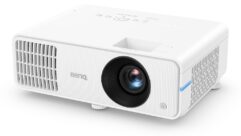
BenQ FP231W
Oct 1, 2004 12:00 PM,
By Jeff Sauer
BenQ is one of the highest-volume manufacturers of desktop LCD monitors in the world, but not much of a pioneer. Not concerned with premiering the latest, largest LCD panels, BenQ’s business is more about finding the price/performance sweet spot that attracts the most consumers. That means prospective buyers can expect solid, proven display products at reasonable prices. It also means that as the LCD market expands, BenQ will be right there with capable products to match. That’s pretty much the case with BenQ’s new 23-inch professional LCD, the FP231W.
FORM AND FUNCTION
At 23 diagonal inches and with a 16:9 wide aspect ratio, the FP231W is BenQ’s largest desktop LCD. Admittedly, that’s nothing to scream about when there are several 23-inch LCDs available. What’s more, you’ll find plenty of 23-inch desktop monitors for a lot less than the $2,359 MSRP of the FP231W. However, not many of those others have a 1920-by-1200 native resolution (WUXGA), and even fewer include multisync video inputs. That brings me back to BenQ’s strength: value.

For BenQ value starts with solid industrial design. After all, a company that caters to the high-volume consumer market needs good-looking products that people would want to own. The FP231W has an understated elegance. A simple ⅝-inch silver bezel frames the screen. Menu touch controls are slightly inset and hidden along the left side of the panel. The panel sits atop a matte black, slightly curved base. A built-in cable clip neatly hides connection cables behind the vertical support arm.
The design is also functional. A release button allows that support arm to move up and down more than five inches. You can also swivel the entire monitor left and right up to 45 degrees without moving the base and tilt the monitor upward some 20 degrees. That makes the FP231W not only a handsome and ergonomic desktop monitor but also a viable presentation or collaboration display for a smaller conference room or design office.
BenQ has also built a helpful four-port USB 2.0 hub into the FP231W. There’s a port on the back panel with the rest of the connections, two easily accessible ports on the left side of the monitor below the menu control buttons, and on the top of the monitor a fourth that’s reserved for a videoconference or Web camera. That allows you to keep the area around the monitor as free of clutter and cables as possible.
The rest of the connections are basic. A 15-pin D-sub and a DVI connector are for data inputs and a composite and an S-video port are for video inputs. With the monitor’s high native resolution, it would be nice to see component video inputs in order to maintain the quality from high-definition video sources. This lack ultimately restricts the FP231W’s possible uses.
A strong 16 ms refresh rate keeps video and other motion content relatively free of LCD ghosting artifacts. Admittedly, professional eyes will still see a little ghosting, especially in a side-by-side comparison with something like a plasma monitor, but professional video is not the primary market for this unit. And heck, 16 ms is a lot better than you’ll find in most LCD TVs in the consumer market.
BenQ has included a picture-in-picture (PiP) feature that allows you, for example, to integrate video and data feeds into the same presentation. The functionality of the PiP mode is quite good, though not for sizing and positioning the inset. There are only three preset sizes for the PiP with no ability to customize them. Worse, the largest is less than a quarter of the full screen. There are no presets for positioning — only the ability to move a PiP around the screen manually via tedious H-pos and V-pos slider controls. BenQ has done better with PiP positioning in its projectors and should have been able to bring the same technology to the FP231W.
On the other hand, the PiP menu allows you to adjust the brightness, contrast, hue, and saturation of the PiP inset independently of the same adjustments to the main image. That, along with the high resolution of even a small inset image, allows you to display a sharp and clear — indeed, a usable — PiP image.
MEASURING UP
As you might expect given BenQ’s price/performance focus, the image quality of the FP231W is good but not great. BenQ’s default color setup is solid, and that’s a good start. According to ColorFacts test equipment, default blue and red levels were slightly higher than ideal and green a little lower, but only by a few percentage points. Adjustments are easy enough to make in the onscreen menus.
I measured the default color temperature at almost exactly the 6,500 degrees Kelvin standard for white point. Further, BenQ offers three other color temperature presets — intuitively labeled Bluish, Reddish, and sRGB — as well as independent red, green, and blue level adjustment to help properly set up the monitor, accounting for ambient light or personal preferences. I also found the FP231W’s gray-scale tracking to be surprisingly good and linear. That allows the unit’s color to remain rich in both bright and dark screens.
BenQ lists the brightness of the unit at 250 cd/m2, and I measured pretty close to that. I actually measured 275 cd/m2, though that was with the brightness improperly pushed all the way up. Using BenQ’s default brightness, I measured a more practical 239 cd/m2.
The caveat with the FP231W is in black levels and, in turn, contrast ratio. The 130:1 contrast ratio I measured is a far cry from the 500:1 that BenQ lists in the unit’s specifications. It’s easy enough to see why with the naked eye: blacks are not particularly black. For example, if you configure the monitor’s aspect ratio to match an incoming 4:3 signal one for one (rather than using the full wide-screen width), you’ll get the expected black bars on the sides of the image. The problem is that those bars are noticeably deeper than any blacks in the image. The bottom line is that “black” tends to be at about 2 cd/m2, and that’s far too bright to maintain a solid contrast.
Still, if you keep BenQ’s target market in mind — as well as the relatively low price for the high-resolution, 23-inch display — the higher-than-ideal black levels are easy to put into perspective. The audience for the FP231W is business professionals looking for a large and attractive, if not very impressive looking, display on their desktops — as well as for conference rooms and other small group meeting areas. To the extent that those professionals are not likely to use the FP231W in a video screening room or in some other video-centric configuration, the display starts to look pretty sharp, both figuratively and literally.
SPECIFICATIONS
LCD Size 23 diagonal inches
Display Area 20× × 12×
Pixel Pitch 0.258 mm
Brightness 250 cd/m2
Contrast 500:1
Viewing Angle (H/V Degrees) 176/176
Response Time 16 ms
Display Colors 16.7 million
True Panel Resolution (Max.) 1920 × 1200 (WUXGA)
Horizontal Frequency (Max.) 30-81 kHz
Vertical Frequency (Max.) 50-76 Hz
Video Bandwidth 25-165 MHz
Input Connector (1) D-sub, (1) DVI-D, (1) S-video, (1) composite
Power Supply (90-264 AC) Adapter
Power Consumption (On Mode) 120W
i Key (Autotuning) Yes
Kensington Lock Support Yes
Dimensions (W × H × D) 21.1″ × 18.3″ × 9.8″
Gross Weight 26.7 lb.
Net Weight 19.4 lb.
Speaker Optional 4W×2
USB 4-port
VESA WallMounting 100 × 100 mm
Swivel Yes
Pivot No
Signal Cable (1) VGA cable, (1) DVI cable
Others Optional Webcam, TCO, TCO’03
PRODUCT SUMMARY
Company: BenQ; www.benq.com
Product: FP231W
Pros: Good image quality and easy color adjustments; good gray-scale tracking.
Cons: Blacks are not particularly black, leading to disappointing contrast.
Applications: High-resolution display for desktops and meeting rooms.
Price: $2,359










